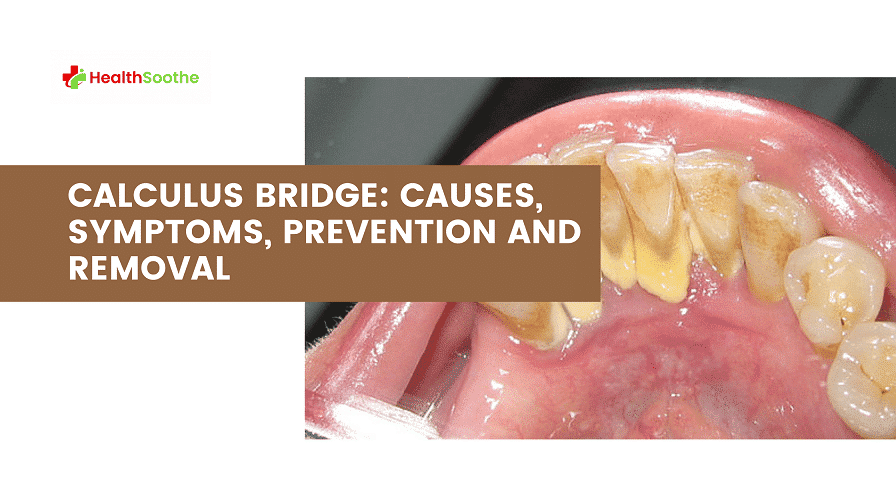A calculus bridge, also known as a tartar bridge, is when deposits of calculus or tartar build-up on your teeth and cause the gums to recede, resulting in an unsightly line of brown or tan along the edge of your teeth by your gumline.
In some cases, this unsightly line looks more like a dark line that runs across the teeth’s surfaces, rather than along the gumline. Either way, it’s not something you want hanging around your smile!
What is a calculus bridge?
As plaque accumulates on teeth, dental calculus can form. Calculus is a hard yellow-brown substance that forms when minerals in saliva mix with compounds from food. The main component of calculus is hardened calcium phosphate.
Calculus on teeth is often referred to as tartar or plaque buildup. The calcified layer or bridge that forms between your teeth will resemble a border of brown or tan along your gumline.
If you don’t remove it using a dental tool called an explorer, within several months it will continue to grow up and become very visible. Calculus bridges are more common in people who are heavy smokers because nicotine increases mouth acidity levels that promote plaque formation.
Read Also: What Does a Cavity Look Like?
What causes it?

A calculus bridge is caused by a substance called dental calculus. Calculus is mineral deposits that form on teeth in reaction to plaque and other chemicals found in saliva. Over time these harden into tartar or calculus buildup around your gums.
You may be able to see a yellow or brownish ring forming around your gumline after your teeth have been brushed. The yellow stain you notice on your finger after brushing is dental calculus that has come off of your teeth during brushing.
The deposit becomes so hard it starts digging into enamel which causes white spots to appear on your tooth surface. This is called a white spot lesion (WSL). If not treated these can turn into cavities which need fillings.
These calculus Deposits on the teeth are, but not limited to :
- Food debris.
- Material alba.
- Dental plaque.
- Dental calculus.
- Dental stain.
Symptoms of calculus build-up

Calculus buildup can lead to receding gums and gum infections, as well as increased tooth sensitivity. Because calculus is a large conglomeration of minerals and other substances that calcify on teeth over time, if it’s not removed regularly it can become quite hardened.
This makes calculus removal much more difficult than normal plaque removal. It also leads to increased tooth sensitivity because calculus builds up under your enamel, which then causes your enamel to be thinner than normal and more susceptible to wear and tear.
The best way to prevent calculus build-up is by brushing twice daily with fluoride-based toothpaste (to strengthen your enamel) for two minutes each time you brush.
You should also floss at least once per day to remove particles from between your teeth that are too small for you to reach with a toothbrush alone.
Subgingival calculus formation and chemical dissolution
Dental calculus (also called tartar or dental plaque) is a mineralized biofilm on tooth surfaces formed by bacterial interactions with saliva. If left untreated, calculus can cause periodontal (gum) disease which will, in turn, cause bone loss around your teeth.
Additionally, if there is not enough room for your teeth to come together because of the formation of calculus around them (sometimes forming abutments), you may lose one or more teeth as they become cracked or broken due to an inability to grind properly.
To prevent these problems from occurring you must remove calculus deposits as soon as possible by working with your dentist. There are two general ways to accomplish removal – chemical dissolution and mechanical removal.
Side effects of calculus build-up

According to some sources (like MedlinePlus), calculus on teeth may cause harm to your oral health by crowding your teeth or causing gum disease.
Some additional symptoms of calculus buildup include
- Bad breath
- Bleeding gums and
- Tooth sensitivity
- Jawbone loss
- Bone erosion
To help prevent these side effects from occurring in your mouth, it’s important to make a habit of brushing your teeth twice daily with fluoride toothpaste for at least two minutes each time.
If you notice that there is some visible brown or tan discolouration around the edge of your gumline, schedule an appointment with our office right away!
Read Also: Are Sugar-Free Drinks Damaging Your Teeth Without You Knowing?
What are the systemic infections of calculus Deposits on the teeth?
- Septicemia
- Endocarditis
- Cardiovascular diseases
- Low birth weight:
What are treatment options?
There are few treatment options for calculus bridges.
- First, try whitening toothpaste or an at-home whitening kit to try to remove some of it. Be sure not to brush too hard with these products as they can damage your teeth if used incorrectly.
- Once you’ve done everything you can at home, seek out a dentist appointment as soon as possible—they can get it off quickly and easily while ensuring that your teeth don’t become even more damaged in the process.
Sometimes it may be necessary to drill into your tooth to get all of the calculus bridge off; once your dental professional has removed what they can reach on their own, they might need to access areas that aren’t visible from the outside of your mouth.
Prevention of calculus
- When you brush your teeth twice a day (and don’t forget to floss), it helps to dislodge food that can settle on your teeth. This can help prevent calculus from building up.
- To further minimize calculus buildup, use an anti calculus toothpaste containing triclosan or sodium pyrophosphate.
- If possible, visit your dentist for a cleaning every six months to remove plaque and tartar—both factors in calculus formation—before they harden into calculus. This should be done by a dental hygienist.
Myths about calculus bridges
Calculus bridges are just as common as other types of dental bridges; however, some myths about them should be debunked.
One of these misconceptions is that a calculus bridge is always an early sign of gum disease. This is false because there can be several other reasons why you might have calculus on your teeth.
For example, a calculus bridge might simply be caused by bad flossing habits or by brushing too hard without flossing. You may also be wondering if it’s possible to remove a calculus bridge yourself or if you will need to see a dentist for help.
Many people opt for removing them at home but doing so incorrectly could lead to bigger problems down the road such as permanent damage or lost teeth.
Read Also: 4 Reasons Why Flossing is So Important
In Conclusion
Although a calculus bridge can be annoying, removing it is not difficult. There are several home remedies you can try before making an appointment with your dentist.
Most of these treatments can get rid of the calculus bridge in a matter of days or weeks. If all else fails, visit your dentist.
He or she will use a procedure called scaling to remove calculus from your teeth. Afterwards, you should brush your teeth regularly to prevent future buildups from occurring.
The most important thing to remember when dealing with calculus bridges is to never wait too long before seeking treatment for it; left untreated for too long, this condition could cause larger problems like cavities or gum disease that are harder to fix and more expensive to treat.




